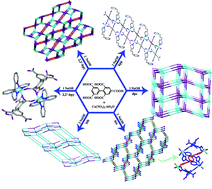Biphenyl-2,4,6,3′,5′-pentacarboxylic acid as a tecton for six new Co(ii) coordination polymers: pH and N-donor ligand-dependent assemblies, structure diversities and magnetic properties†
Abstract
Six new Co(II)-based mixed-ligand coordination polymers, namely, [Co2(H3bppc)2(2,2′-bpy)4]·H2O (1), [Co2(Hbppc)(2,2′-bpy)2(H2O)]·H2O (2), [Co(H2bppc)(H-bpp)]·2H2O (3), [Co3(μ3-OH)(bppc)(dps)(CH3CH2OH)]·4H2O (4), [Co2(bppc)(bib)(H2O)4]·(H2-bib)0.5·(H2O)3 (5), and [Co2(Hbppc)(bix)2]·2H2O (6), (H5bppc = biphenyl-2,4,6,3′,5′-pentacarboxylic acid, 2,2′-bpy = 2,2′-bipyridine, bpp = 1,3-bis(4-pyridyl)propane, dps = 4,4′-sulfanediyldipyridine, bib = 1,4-bis(imidazol-1-yl)benzene, bix = 1,4-bis(imidazol-1-ylmethyl)benzene), have been obtained under solvothermal conditions. 1 exhibits a 3D supramolecular framework based on a [Co2(H3bppc)2(2,2′-bpy)4] unit. 2 has a (3,4)-connected dmc net with a (4·82)(4·85) topology containing alternate binuclear metal clusters and single metal centres. 3 shows a 3D supramolecular architecture constructed from ladder-like arrays decorated with H-bpp. 4 exhibits a binodal (5,7)-connected 3D network based on trinuclear [Co3(μ3-OH)]5+ units with an unusual (3·46·52·6)(32·46·57·65·7) topology. 5 features a (4,6)-connected 3D fsc open framework with binuclear [Co2(H2O)(COO)]3+ units as nodes, and H2-bib and water molecules located in the voids of its framework by hydrogen bonds. 6 possesses a 3D net containing unusual 2D polyrotaxane sheets. Topological analysis reveals that 6 has a (3,4,4)-connected 3D network with a (4·6·74)(4·6·7)(6·72·102·11) topology. The structural difference of 1 and 2 is due to the different pH values of the reaction system. Though complexes 2–6 were synthesised under similar reaction conditions, the carboxylic groups of H5bppc were partially deprotonated in 2, 3 and 6 and fully deprotonated in 4 and 5. Complexes 2–6 display diverse structures depending on different N-donor ligands and the coordination modes of the multicarboxylate ligand. Variable-temperature magnetic susceptibility measurements reveal that complexes 1–6 show antiferromagnetic interactions.


 Please wait while we load your content...
Please wait while we load your content...